September, 1960
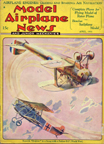
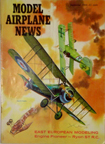
Two Views of the Same Event, 30 years Apart
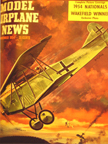
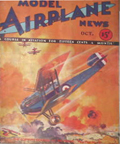
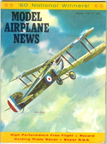
Fokker D. VII and Sopwith 5F.1 "Dolphin"
Model Airplane News Cover Art for April, 1931, October, 1932, November, 1954, and October, 1960
by Jo Kotula
Click to Enlarge
The duel between the Dolphin and the Fokker was portrayed twice on the cover of Model Airplane News - once (in April, 1931) within memory of World War One, the latter (September, 1960) during the magazine's retrospective look at the aircraft of the Great War.
Fokker D. VII
The Sopwith "Dolphin" is covered further below
The Fokker D.VII was a German World War I fighter aircraft designed by Reinhold Platz of the Fokker-Flugzeugwerke (Aircraft Company). Germany produced around 1,700 D.VII aircraft in the summer and autumn of 1918. It was such a formidable aircraft that the Armistice ending the war specifically required Germany to surrender all D.VIIs to the Allies.
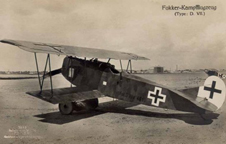
Fokker D-VII
Click to Enlarge
Late in 1917, Fokker built an experimental biplane fitted with the standard Mercedes D.IIIa engine. Upon flying the modified V.11,Manfried von Richthofen (the "Red baron") praised its excellent performance, safety and ease of flying, especially for new pilots. Fokker immediately received a provisional order for 400 production aircraft, which were designated "D.VII" by the German Air Force.
Fokker's factory was not up to the task of supplying the entire air force, so their rivals at Albatros and AEG were directed to build the D.VII under license. Because Fokker did not use production plans for their designs, they simply sent a completed D.VII airframe for Albatros to copy. Albatros paid Fokker a five percent royalty for every D.VII built under license. Ultimately, 1700 models of the D-VII were produced.
I actually built the Cleveland Master KIt for the Fokker D-VII in 1955
When I was a kid in the 1950s,I used to hang out at the athletic field next to St. John's church in Bloomfield. This was not a lovely grass covered area, but rather an oiled dirt playing field. On Sundays, teenagers and men would gather to fly gasoline-powered model airplanes. This was a fascinating experience that captivated me. After some interaction with the modelers, I learned that the Boys Club offered lessons in making models for little kids. So, I started out there. It wasn't long before I heard people talk about the famous "Cleveland Model Airplanes." These were incredibly detailed models that took a high degree of skill to make. They also cost a dollar when the simple kits we made at Boys Club cost a dime. My teachers suggested that I stick to the "kids kits."
This was, of course like waving a red flag at a bull. Back then, my parents were very poor, so asking for a dollar for a model airplane kit that people said I couldn't make was out of the question. I had to hustle a lot to get the dollar. At that time, you could get a nickle if you carried groceries up five flights of stairs. The deal was cinched when I actually found a quarter on the street outside a bar.
I walked into Pop Target's candy store --- for some reason, he stocked a wide variety of model airplane kits --- and plunked down my dollar for the Cleveland Kit, for the Fokker D-VII. I took this back to the Boys Club and worked on it every day for the hour we were alotted. It actually took two years to finish. During that time, I actually got promoted to be one of the "helpers" for new kids. When I finished it, Mr. Ravignoli (the teacher) took a picture of me. He sent the picture to Model Airplane News which was the holy scripture of aircraft fans. The picture and the letter that I received from William Winter are shown below.

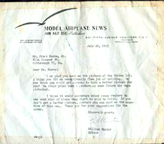
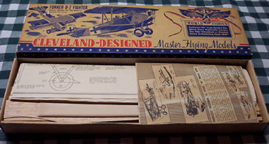
My 1955 Rendition of the Cleveland Fokker D-7 Kit
William Winter was the Dean of Aircraft Modelers at the time
Picture at the right is the Cleveland Master Kit
Click to Enlarge
Click here to learn more about the Fokker D-VII. Below is a fantastic video of a model of a Fokker D-VII in action. It has all the qualities of the real thing. The D-VII has always been an excellent subject for modeling!
In fact, Cleveland made a number of kits for the Fokker D-VII. The most valuable and challenging is the Master Kit.

Fokker D-VII on the Cleveland Site
Click to Enlarge
You can buy the plans and patterns that will enable you to make this model right now. Click Here to go to the exact location on the Cleveland Website to get them.
Sopwith "Dolphin"
The 5F.1 Dolphin was designed to provide the pilot with the best possible view with his head in the open framework connecting the upper mainplanes. The plane was constructed of fabric-covered wire-braced wooden members with an upper centre section of steel tube. The Dolphin was powered by an eight-cylinder water-cooled engine . Armament consisted of two fixed and synchronised 7.7mm guns and either one or two guns of similar caliber mounted over the wing centre section and movable, but usually firing forwards and upwards. The prototype was flown in late May 1917, the first production contract was placed in the following month. Quantity deliveries to the RFC began late in the year. The first Dolphin squadron was deployed to France in February 1918. Production of the Dolphin totalled 1,532 aircraft, of which all but 121 were built during 1918. The Dolphin was finally withdrawn from RAF service mid 1919.


Sopwith 5F.1 "Dolphin"
Click to Enlarge
Here is a video showing various aspects of the of the Sopwith 5F.1 "Dolphin":
Click Here for more information about the Sopwith 5F.1 "Dolphin".

Click to go back and select another cover.
Counter for the Entire Site (not just this page..)
Home | About Lindy | Last Week's Reviews | Upcoming Events | 1940s Collecibles
The Guide - Establishments - Travel - Accessories
Music | Links | Photo Gallery | Extras | Contact